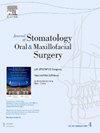头颈癌治疗患者的挥发性硫化合物和唾液参数:一项初步研究。
IF 1.8
3区 医学
Q2 DENTISTRY, ORAL SURGERY & MEDICINE
Journal of Stomatology Oral and Maxillofacial Surgery
Pub Date : 2024-11-17
DOI:10.1016/j.jormas.2024.102158
引用次数: 0
摘要
背景:头颈部鳞状细胞癌(HNSCC)的治疗通常会产生各种不良反应,包括唾液参数变化和口臭。本研究旨在调查接受 HNSCC 治疗的患者体内挥发性硫化合物(VSC)水平和唾液参数的变化:这项前瞻性纵向研究在巴西一家肿瘤中心进行,方便抽样调查了 24 名正在接受放疗或化疗的 HNSCC 患者,评估了他们的 VSC 水平、唾液流量、pH 值、粘度、口干和舌苔。评估在抗肿瘤治疗开始和结束时进行。使用口腔 ChromaTM 气相色谱仪测量 VSC 水平。对数据进行了描述性和分析性分析:结果:总体 VSC 水平未发现明显变化。结论:HNSCC 的治疗会导致唾液流量减少:HNSCC治疗会导致唾液流量减少、pH值改变和唾液粘度增加。虽然自我报告的口臭与治疗后硫化氢水平升高有关,但未观察到整体 VSC 浓度有明显变化。本文章由计算机程序翻译,如有差异,请以英文原文为准。

Volatile sulfur compounds and salivary parameters in patients undergoing head and neck cancer treatment: A preliminary study
Background
Treatment for head and neck squamous cell carcinoma (HNSCC) is often associated with various adverse effects, including changes in salivary parameters and complaints of halitosis. This study aimed to investigate changes in volatile sulfur compound (VSC) levels and salivary parameters in patients undergoing treatment for HNSCC.
Methods
This prospective longitudinal study was conducted at a Brazilian oncology center, where a convenience sample of 24 HNSCC patients undergoing radiotherapy or chemoradiotherapy were evaluated for VSC levels, salivary flow, pH, viscosity, dry mouth, and tongue coating. Assessments were performed at the beginning and end of antineoplastic therapy. VSC levels were measured using an Oral Chroma™ gas chromatograph. Data were analyzed descriptively and analytically.
Results
No significant changes were found in overall VSC levels. However, a statistically significant reduction in salivary flow (p < 0.001) and pH (p = 0.017) and an increase in salivary viscosity (p = 0.037) were noted post-treatment. Patients who reported halitosis after treatment exhibited significantly higher hydrogen sulfide levels (p = 0.045). Tongue coating and VSC levels showed no significant changes.
Conclusion
Treatment for HNSCC results in reduced salivary flow, altered pH, and increased salivary viscosity. Although self-reported halitosis correlates with elevated hydrogen sulfide levels post-treatment, no significant changes in overall VSC concentrations were observed.
求助全文
通过发布文献求助,成功后即可免费获取论文全文。
去求助
来源期刊

Journal of Stomatology Oral and Maxillofacial Surgery
Surgery, Dentistry, Oral Surgery and Medicine, Otorhinolaryngology and Facial Plastic Surgery
CiteScore
2.30
自引率
9.10%
发文量
0
审稿时长
23 days
 求助内容:
求助内容: 应助结果提醒方式:
应助结果提醒方式:


